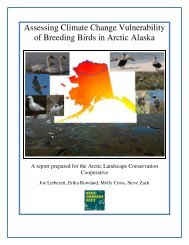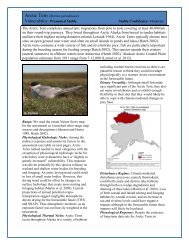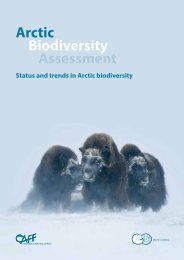Permafrost Terrain Stability and Thermokarst Monitoring: - Arctic LCC
Permafrost Terrain Stability and Thermokarst Monitoring: - Arctic LCC
Permafrost Terrain Stability and Thermokarst Monitoring: - Arctic LCC
You also want an ePaper? Increase the reach of your titles
YUMPU automatically turns print PDFs into web optimized ePapers that Google loves.
52. Hinkel, K.M., <strong>and</strong> Hurd, J.K., 2006, <strong>Permafrost</strong> destabilization <strong>and</strong> thermokarst<br />
following snow fence installation, Barrow, Alaska, USA: <strong>Arctic</strong>, Antarctic, <strong>and</strong> Alpine<br />
Research, v. 38, no. 4, p. 530–539.<br />
This paper describes the effect of a snow fence on permafrost temperature <strong>and</strong> l<strong>and</strong><br />
subsidence in Barrow, Alaska, from 1999 to 2005. Data loggers were installed at depths of<br />
5, 30, <strong>and</strong> 50 cm in the ground on the downwind side of the snow fence <strong>and</strong> in tundra sites<br />
not affected by the snow drifts that formed as a result of the snow fence. Active layer<br />
thickness <strong>and</strong> snow depth were measured annually in August <strong>and</strong> April, respectively. As a<br />
result of the snow fence, the ground temperature in the downwind strip has warmed by 2–<br />
14°C in the winter, <strong>and</strong> has cooled by 2–3°C in the summer because of the time it takes to<br />
melt the drifted snow (3–4 m in thickness). The net effect has been a warming of the ground<br />
surface, a thawing of the permafrost, subsidence of about 10–20 cm, <strong>and</strong> development of<br />
thermokarst ponds. This study highlights the importance of snow accumulation <strong>and</strong><br />
thickness on the ground thermal regime <strong>and</strong> potential to form thermokarst in areas where air<br />
temperatures are thought to be too cold for the formation of thermokarst.<br />
53. Hinkel, K.M., Jones, B.M., Eisner, W.R., Cuomo, C.J., Beck, R.A., <strong>and</strong> Frohn, R.,<br />
2007, Methods to assess natural <strong>and</strong> anthropogenic thaw lake drainage on the western<br />
<strong>Arctic</strong> coastal plain of northern Alaska: Journal of Geophysical Research, v. 112,<br />
no. F2, F02S16.<br />
This paper describes three methods for assessing the natural <strong>and</strong> anthropogenic drainage of<br />
thermokarst lakes on the western <strong>Arctic</strong> Coastal Plain of northern Alaska: (1) comparison of<br />
L<strong>and</strong>sat imagery between about 1970 <strong>and</strong> about 2000 for a 35,000-km 2 area, (2) comparison<br />
of historical aerial photography from 1949 to 1955 with recent high-resolution orthorectified<br />
radar derived imagery from 2002 for the Barrow Peninsula, <strong>and</strong> (3) interviews with local<br />
<strong>and</strong> traditional knowledge holders. About 50 lakes larger than 10 ha drained in the 25-year<br />
period were analyzed with an automated classification of the L<strong>and</strong>sat imagery. This analysis<br />
showed that only 0.027 percent of the extant lakes in the region had catastrophic drainage<br />
during this time period. The authors also attempted to classify the lake drainage events by a<br />
mechanism that included lake coalescence (19), coastal erosion (1), stream me<strong>and</strong>ering (8),<br />
headward erosion (13), <strong>and</strong> unresolvable (9). By extending the analysis back to 1950 with<br />
the automated classification of the aerial photography for the Barrow study region the<br />
authors showed that human activity was responsible for about 40 percent of the lake<br />
drainage events on the Barrow Peninsula. The timing <strong>and</strong> mechanism of select lake drainage<br />
events were further refined through the interviews with the traditional <strong>and</strong> local knowledge<br />
holders.<br />
20








